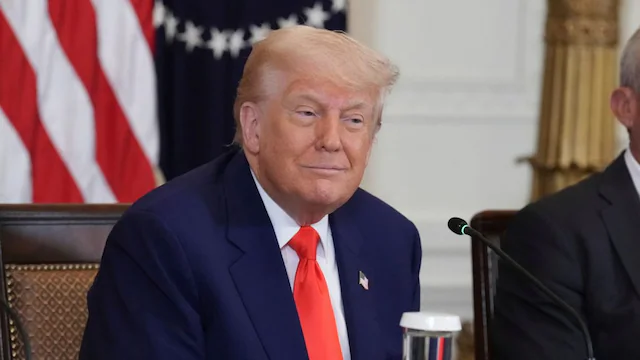- Courses
- GS Full Course 1 Year
- GS Full Course 2 Year
- GS Full Course 3 Year
- GS Full Course Till Selection
- Online Program
- GS Recorded Course
- NCERT (Recorded 500+ Hours)
- Polity Recorded Course
- Geography Recorded Course
- Economy Recorded Course
- AMAC Recorded Course
- Modern India, Post Independence & World History
- Environment Recoded Course
- Governance Recoded Course
- Science & Tech. Recoded Course
- International Relations and Internal Security Recorded Course
- Disaster Management Module Course
- Ethics Recoded Course
- Essay Recoded Course
- Current Affairs Recoded Course
- CSAT
- 5 LAYERED ARJUNA Mentorship
- Public Administration Optional
- ABOUT US
- OUR TOPPERS
- TEST SERIES
- FREE STUDY MATERIAL
- VIDEOS
- CONTACT US
Donald Trump's 'One Big Beautiful Bill Act of 2025' (OBBBA)
Donald Trump's 'One Big Beautiful Bill Act of 2025' (OBBBA)
30-05-2025

-
The "One Big Beautiful Bill Act of 2025" (OBBBA), passed by the US House of Representatives in May 2025.
- It is a flagship legislative initiative of President Donald Trump's 2nd term.
- It is now awaiting deliberation in the US Senate.
- Its passage has sparked significant debate regarding its economic and political ramifications.
I. What the Bill Aims to Do ('Big and Beautiful' Aspects):
The OBBBA essentially consolidates President Trump's key policy agenda and campaign promises into a single legislative document. Its 5 core elements are:
- Extension and Permanence of 2017 Tax Cuts: it makes permanent the income tax and estate tax cuts introduced during Trump's first term (2017).
- New Tax Cuts: it introduces new tax cuts on overtime, tips, and social security incomes.
- The White House claims this will result in a 15% tax cut for Americans earning between $30,000 and $80,000 annually.
- Increased Spending on Border Security and Defence: it allocates more funds for border security (to curb illegal immigration) and to enhance US military and defence capabilities.
- Reduction in Government Waste: it aims to cut down on "waste, fraud and abuse" in government spending.
- Raising the Debt Ceiling: it proposes to raise the US debt ceiling, which is the statutory limit on how much the US government can borrow, to ensure the government can pay its bills.
II. Criticisms and Concerns ('Not So Beautiful' Aspects):
The Bill has drawn significant criticism from economists and members of Congress (including some Republicans) primarily on two broad fronts:
A. Adverse Fiscal and Macroeconomic Impact:
- The combination of significant tax cuts and increased spending (especially on border security and defense) is projected to further worsening US government finances.
- Already High Federal Deficit: The US federal deficit (government spending - government earnings) is already at approximately 6.4% of US GDP in 2024, more than double what is considered acceptable by many.
- The OBBBA is expected to increase this further.
- Rising National Debt: Each year's deficit adds to the overall national debt.
- The US debt-to-GDP ratio has rapidly risen to 120% and is projected to reach 200% within the next decade, a trend considered unsustainable by policy experts, including the US Federal Reserve Chair.
- Investor Wary and Falling Credit Ratings:
- Global investors are increasingly hesitant to lend to the US government due to concerns about sustainability.
- On May 17, Moody's stripped US government debt of its triple-A rating, marking the 1st time none of the top three credit rating agencies (Fitch, S&P, and Moody's) rate US government debt as top-notch. Moody's estimates federal deficits could grow to 9% of US GDP by 2035.
- Rising Bond Yields: As investors pull away from US dollar-denominated bonds, their prices fall, and yields rise (interest rates paid by the government to bondholders)
- This implies the US government will have to pay higher interest rates on its borrowings, which in turn leads to higher interest rates for US citizens and businesses across the board.
- This implies the US government will have to pay higher interest rates on its borrowings, which in turn leads to higher interest rates for US citizens and businesses across the board.
B. Redistributive Aspects (Anti-Robin Hood Effect):
- Wealth Transfer from Poor to Rich: Economist Justin Wolfers terms the Bill "anti-Robin Hood" due to its design, which is seen as transferring wealth from the poor to the rich. This is achieved through:
- Tax cuts disproportionately benefiting the wealthy.
- Limitations on government assistance to the poor.
- Uneven Distribution of Benefits (CBO Analysis): An analysis by the non-partisan Congressional Budget Office (CBO) highlights that while the Bill might increase overall household resources, the benefits are not evenly distributed:
- Negative Impact on Lowest Income Deciles: Household resources for the lowest 10% of the income distribution are estimated to decrease by 2% (in 2027) and 4% (in 2033), mainly due to losses in "in-kind transfers" such as Medicaid (health insurance) and SNAP (Supplemental Nutrition Assistance Program).
- Positive Impact on Highest Income Deciles: Resources for the highest 10% of the income distribution are estimated to increase by 4% (in 2027) and 2% (in 2033), primarily due to reductions in their tax obligations.
Conclusion:
While the OBBBA is touted as a comprehensive legislative solution to deliver on campaign promises, its fiscal implications, particularly concerning the burgeoning national debt and deficit, and its regressive redistributive effects, are significant concerns that will continue to be debated as it moves through the US legislative process.



